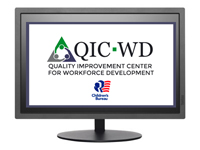Child Welfare Quality Improvement Center for Workforce Development (QIC-WD)
Date of this Version
9-30-2020
Document Type
Article
Abstract
Several national studies have been conducted over the past few years (e.g. Hooyman, & Uniitzer, 2011; Lin, Lin, & Zhang, 2016) to project the number of social workers that will be needed by the year 2030. What they all point to is a huge deficit in the number of social workers (upwards of 200,000) needed to care for children, the elderly and those with addictions, mental health, and other health issues. However, those estimates may be low given that as of 2018 there was no regular gathering of comprehensive data on workforce needs in such areas as child welfare, juvenile justice and medical settings where the jobs have often been de-professionalized (Spetz, et al., 2015; Williams & Vieyra, 2018). Another take away from these studies is that the competition for high quality staff with a social work education is increasing (Fraser, et al., 2018). Increased demand for social workers in other fields, such as education, health care and criminal justice, and in other areas of social work such as mental health and aging, and likely contributing to the drop in the number of students taking advantage of Title IV-E and Title IV-B education programs in child welfare. This trend is impacting the size of the pipeline of social work students into child welfare agencies. In fact, multiple federal agencies in the U.S. Department of Health and Human Services, such as the Health Resources and Services Administration (HRSA) and the Substance Abuse and Mental Health Services Administration (SAMHSA), are funding student stipends to increase the number of social work and other students specializing in behavioral health, integrated health, and gerontology (e.g. Putney, et al., 2017; see the description below of three such programs). The race for talent is on! Behavioral Health Workforce Education and Training (BHWET) Program HRSA established the BHWET program to increase the number of professionals practicing in behavioral health serving those living in medically underserved areas by establishing or expanding internships or field placements for students and interns, faculty, and supervisors. Center for Integrated Health Solutions (CIHS) This center “promotes the development of integrated primary and behavioral health services to better address the needs of individuals with mental health and substance use conditions,” whether seen in a specialty behavioral health setting or in primary care provider settings. CIHS is run by the National Council for Behavioral Health and is an interagency collaboration between SHMHSA and HRSA. There is an emphasis on developing the workforce to work in integrated health settings. Geriatric Workforce Enhancement Program (GWEP) HRSA established the GWEP program to increase the number of professionals practicing in health care with a focus on patient and family engagement by integrating geriatric care to improve health outcomes for older adults. The QIC-WD is studying the impact of employee selection protocols on worker job performance and retention. The QIC-WD is also testing the effectiveness of using psychological testing to help find those who are likely to fit the front level child welfare job the best. Once these studies are completed, we will have more data regarding whether or not the pool of applicants was large enough for choice to even be possible. A next step may be expanding recruitment efforts so that the pool of qualified applicants is larger. On another front, the QIC-WD is studying the impact of educational degree (e.g. social work, psychology, family studies) and participation in Title IV-E education programs on worker retention and outcomes for children across all of our sites. This will be one of the few national studies on the impact of degree and preparation on these important outcomes. We may also see if the number of social workers in child welfare is declining, remaining stable, or increasing. If the numbers are declining, we hope that our findings can be a call to action to university schools of social work to find ways to overcome barriers to recruitment of students into Title IV-E education programs and the child welfare field.
Included in
Industrial and Organizational Psychology Commons, Performance Management Commons, Public Policy Commons, Social Welfare Commons, Social Work Commons, Training and Development Commons


